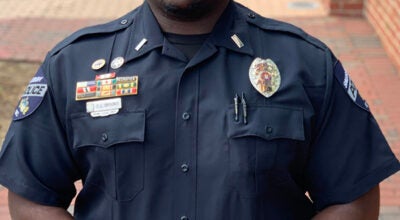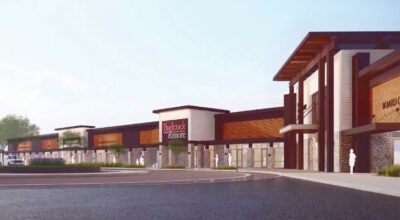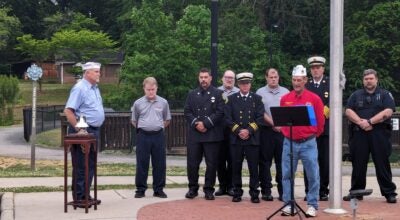New school projects unfunded
Published 12:00 am Saturday, January 1, 2011
By Sarah Campbell
scampbell@salisburypost.com
The Rowan-Salisbury School System needs more than $128 million in additions and renovations during the next five years, but Gene Miller, the districtís assistant superintendent for operations, said the majority of them will go unfunded.
Miller outlines the school systemís needs, which includes constructing new buildings for Cleveland Elementary, Woodleaf Elementary and Knox Middle schools, in a 5-year Facilities Needs Assessment Report.
He will present the report to the Rowan-County Board of Commissioners on Monday for their approval, before sending it in to the state.
Every five years, local school districts are required by state law to submit their long-range capital needs to the State Board of Education.
ěItís just another unfunded mandate,î Miller said.
Miller said the school system isnít asking the county to fund the projects listed in the more than 100 page report, but is required to submit it to them.
ěIt would be wasting our breath, because they donít have it,î he said. ěHowever, by seeing this, they will have some idea of what weíre facing.î
Building new schools
The school system would have to spend more than $44 million to rebuild Woodleaf, Cleveland and Knox.
The total cost to construct each elementary school comes in at about $13.5 million for each elementary school and nearly $17.5 million for Knox Middle.
Miller said itís easy to see why Cleveland and Woodleaf need to be rebuilt, theyíre both more than 80 years old.
Adding technology to the schools can be a challenge.
ěEvery time we add computers, we have to add new wiring capacity,î he said. ěIt would be so much better if you could hook up technology without having to run unsightly wires everywhere.î
Water and sewer problems at Woodleaf are also taxing the school districtís capital outlay budget.
Miller said Clevelandís student population is currently overcapacity for inside the building, which means seven classes are conducted in a modular pod unit.
ěItís eight mobile classrooms put together, seven classrooms and a mobile restroom,î he said. ěItís really not safe. Anytime they have a bad storm or threat of a tornado, we have to evacuate that unit and put the students inside the building where itís safe.î
In 2008, Miller proposed combining Woodleaf and Cleveland elementary schools, but outcry from the community has nixed that plan altogether.
ěItís off the table,î he said. ěIt made sense from an efficency standpoint, but from a community standpoint, it didnít.î
Miller said he considered combining the two schools in order to get the new school built sooner.
ěThe community did not want that and thatís just fine,î he said.
Miller said the problem with Knox isnít with age, but layout. He said the multiple-building school, which has been used as a junior high school in the past, can be an obstacle for discipline.
ěItís hard to control students when theyíre going from building to building,î he said.
The current facility is also not the ěbest from a security standpoint,î Miller said.
Salisbury Police Deputy Chief Steve Whitley said although there has only been one commercial break-in reported at Knox in this year, he agrees the campus is quite large.
ěAnytime you have multiple buildings, than, obviously, from a security standpoint each building kind of stands alone and there have to be plans and procedures in place to ensure safety,î he said.
Whitley said the campusí layout doesnít pose a problem for police in terms of response.
ěIt really doesnít matter if they have one building or 20,î he said. ěîWeíre going to tailor our response to whatís going on.
ěWeíre going to send enough people to deal with it.î
Adding on
Miller said although all 35 of the districtís schools have a fire alarm, none of them is currently linked to 911, which means school staff would have to manually call for help in the case of a fire.
The school system would have to spend more than 650,000 to install new fire alarm systems in every school. And, Miller said, that doesnít include the cost of monitoring the systems.
Miller said the current system serves the purpose of getting students and staff out of the building, but cuts down on the amount of time firefighters have to tame a blaze.
Salisbury Fire Chief Bob Parnell said although there might be a slight delay contacting the fire departments when school is in session, itís when no one is in the building that creates a more serious threat.
ěIf there is nobody there then, of course, the first alarm would not be recognized by anybody,î he said. ěThe sooner we know about a fire, the sooner we can get there and, presumably, less damage will occur.î
Parnell said installing equipment to connect the schools the emergency services is a practical way to protect taxpayer dollars.
ěTo have a significant fire because the alarm systems arenít hooked up and donít automatically notify 911 means damage that occurs to taxpayer-funded buildings,î he said.
The facilities needs assessment also proposes adding auxiliary gyms to every middle and high school in the district.
ěIt would be a second gymnasium that is not used for competition, just practice and (physical education),î Miller said.
Dr. Walter Hart, the districtís assistant superintendent for adminstration, said extra practice space is particularly important this time of year when cold weather forces teams inside.
ěFor example, right now most high schools have junior varsity girls basketball, junior varsity boys basketball, varsity girls basketball, varsity boys basketball, wrestling and variety and junior varsity cheerleading,î he said. ěAll of which need practice space.î
Hart said with only one gym, scheduling practices and classes can become tricky.
ěDuring the day, the reality is that if you were to have two or three P.E. classes running simultaneously if itís a cold weather or bad weather day that translates into a significant number of kids in a gym,î he said. ěIt becomes a challenge as far as being able to do activities.î
Routine maintenence
Miller said roofing and parking lots are considered ěpreventative and routine maintenence items.î
The school district is currently on a cycle to replace either portions or entire roofs before they become problematic. He said they typically last between 10 and 15 years.
ěWe donít have the money to do a lot of roof replacement right now,î he said. ěOur roofs are in fairly good shape right now, but in the next four or five years weíre going to really get into trouble and have a lot of leaking roofs.
Miller said the school system also would need a ěcontinual flow of moneyî to refurbish parking lots, which last about eight to 10 years.
The school system spends about $2 million each year on regular maintenence such as painting, replacing broken windows and doors, repairing water and sewer lines and replacing carpet.
No funding in sight
Miller said this yearís facilities needs assessment doesnít look much different than the one he submitted five years ago.
ěThis report is basically the same,î he said. ěThe big items that are in that report are also in this one.î
Miller said the report is essentially the same because funding continues to dwindle.
ěItís probably going to get worse because when we did this plan five years ago we had not gone into the recession and there was still money to do some things,î he said.
Now, he said, money for capital improvements is even more scarce.
Miller said the approximately $2.5 million the county receives from the North Carolina Education Lottery would help, but those funds are already appropriated to pay off bond debt.
ěIt would be nice right now to have that $2.5 million each year,î he said. ěYou would see a lot less in that (facilities needs assessment.î
But Miller realizes the reality of the Rowan County Commissioners voting to use the lottery dollars for new construction projects is bleak, since it would likely mean a tax hike for residents.
ěTechnically, there is nothing wrong with what theyíre doing,î he said.
Miller said when state officials receive the districtís five-year plan, it will put together a statewide needs assessment.
ěTheyíll come out with one big figure for capital needs,î he said. ěWhen the economy gets stronger … they will hopefully pass another statewide bond referendum.î
Miller said a 1996 state bond referendum provided about $38 million for the district.
School officials said funding for capital projects has become a waiting game, as the list of needs continues to grow.
ěThe reality is that we donít have any funding to do anything right now,î Hart said.
Contact reporter Sarah Campbell at 704-797-7683.





